“Anyone can cook!”
— The ghost of Chef Gusteau, Ratatouille (film)
I hope I don’t come across as arrogant when I say that the above is definitely true in my case. From a young, newly-married bride who couldn’t even boil water to a wife and mother who loves to experiment with cuisines, cooking techniques and ingredients – I have come a long way (still staying humble by the way!) ☺
Before Coronavirus, before social distancing and before lockdown, I was not much of a ‘fancy’ chef. Don’t get me wrong. It’s not that I don’t like to cook, because I do. But until a few months ago, I always cooked simple food that was healthy and nutritious (palatable too, thank you very much!) ☺ Masterchef-level dishes, presentation and degustation were never my style. In fact, my family would constantly rag me, describing my food as ‘Ashram‘ food! My response to such teasing was always the same: “You eat outside (read: unhealthy!) food at least once a week plus lots and lots of junk food whenever we travel. Then why can’t you eat simple food at home? Now shut up and eat!”
So what changed? How did I go from a simple home cook who viewed food as simply a means of sustenance to a passionate foodie who now loves exploring everything related to food? The Coronavirus crisis happened!
Here’s how I began my new culinary journey in the midst of this crisis.
Shah Family presents: The Great Shah Food Festival aka GSFF!
It was my better half’s birthday and my younger sister’s wedding anniversary. Unfortunately, we were all under lockdown so ‘normal’ celebrations were out of the question. I was planning to make Rava Sheera Cake with mango for the birthday boy plus Gulab Jamun for the happy couple. But a friend suggested that I make a cooker chocolate cake instead. She shared her super-easy recipe which I used to bake my first-ever stovetop cake! Only 3 main ingredients required: chocolate Bourbon biscuits, milk and Eno fruit salt.
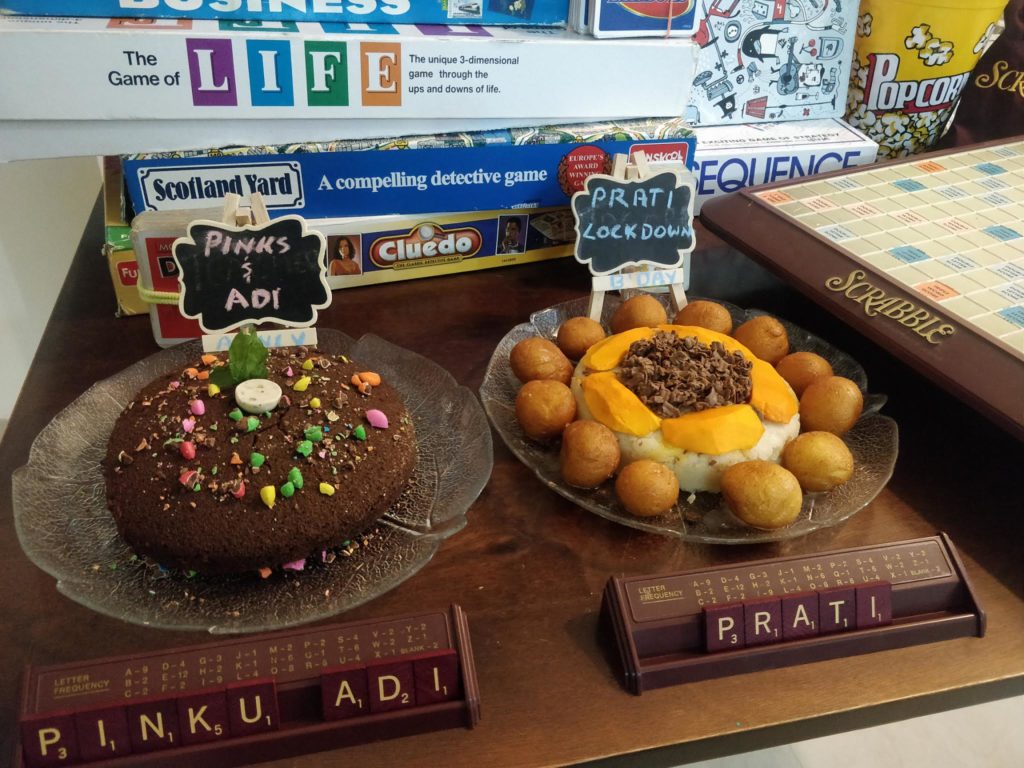
The next GSFF milestone came when my kids requested home-made Dalgona Coffee. At the time this unusual coffee was trending on social media, thanks to the recommendation of a popular Korean actor. When I found the recipe video on YouTube, I realised that Dalgona coffee is simply whipped. Kids usually enjoy the whip-whip-whip process. Mine surely did!
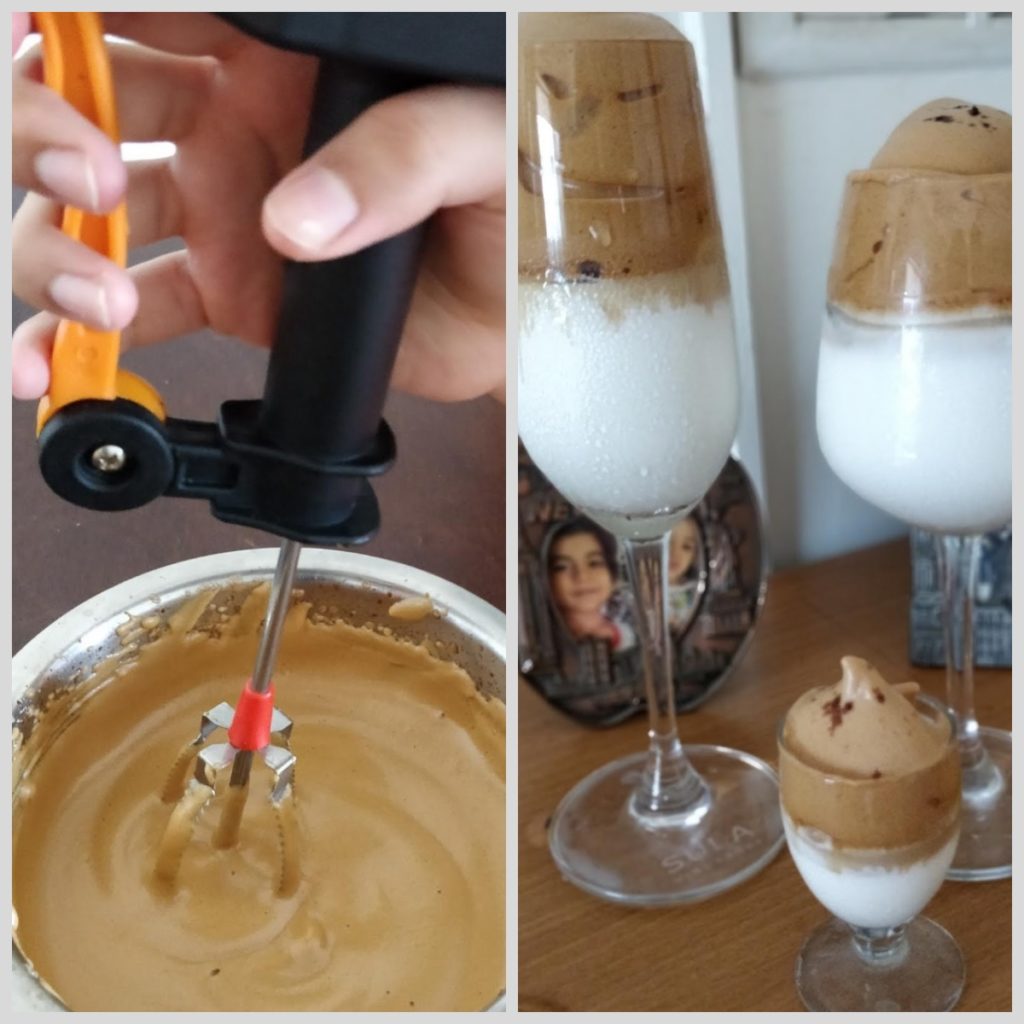
The Dalgona experiment was a super-hit with my kids! That’s when I realised that food could be the primary source of ‘sense gratification’ during the lockdown. So naturally, I continued my culinary explorations and boy, am I glad I did! My mother had given me sizzler plates long (long!) ago which I had used only once before. The second time was during the lockdown. Here’s a picture of the vegetarian sizzler my kids and husband devoured!
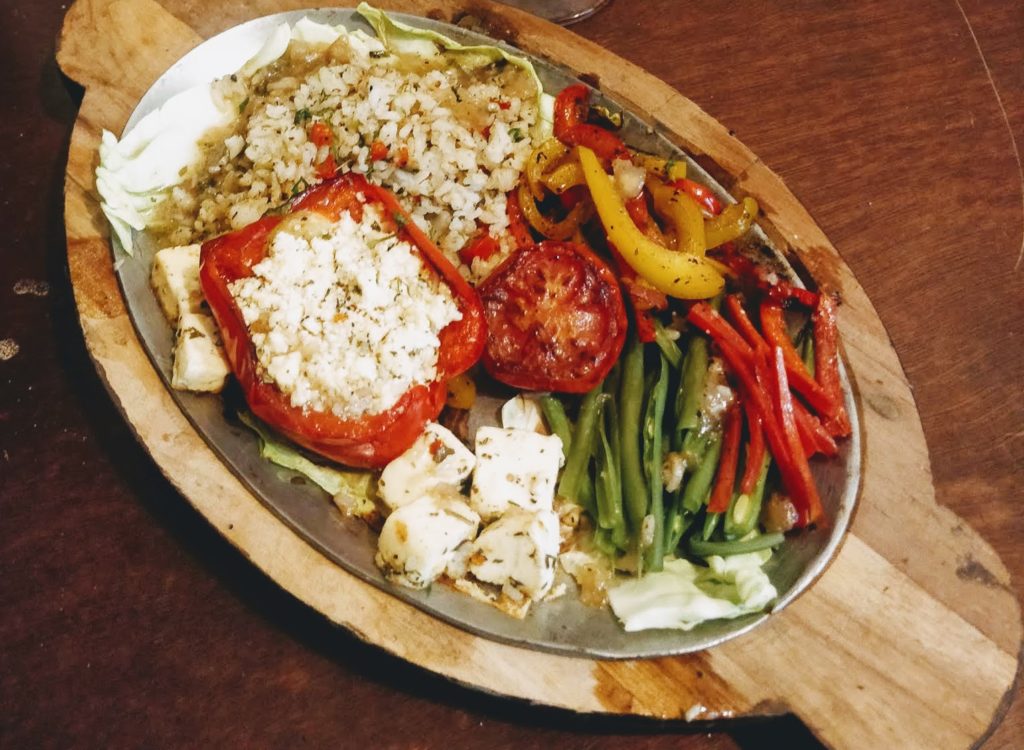
Next on the GSFF journey: the Mumbai Vegetable Sandwich! This simple street food is popular all over India but it originated right here in amchi Mumbai. In fact, in many parts of the country, sandwich vendors name their stalls ‘Bombay Sandwich Stall’ but the taste is not quite the same. Believe me, I have tried dozens so I’m not kidding! A typical Mumbai sandwich is filled with raw veggies or with a spicy potato mixture topped with raw veggies. The ‘toast sandwich’ is usually cooked in a handheld toaster that is placed on a gas stove, instead of in an electric sandwich toaster/griller.
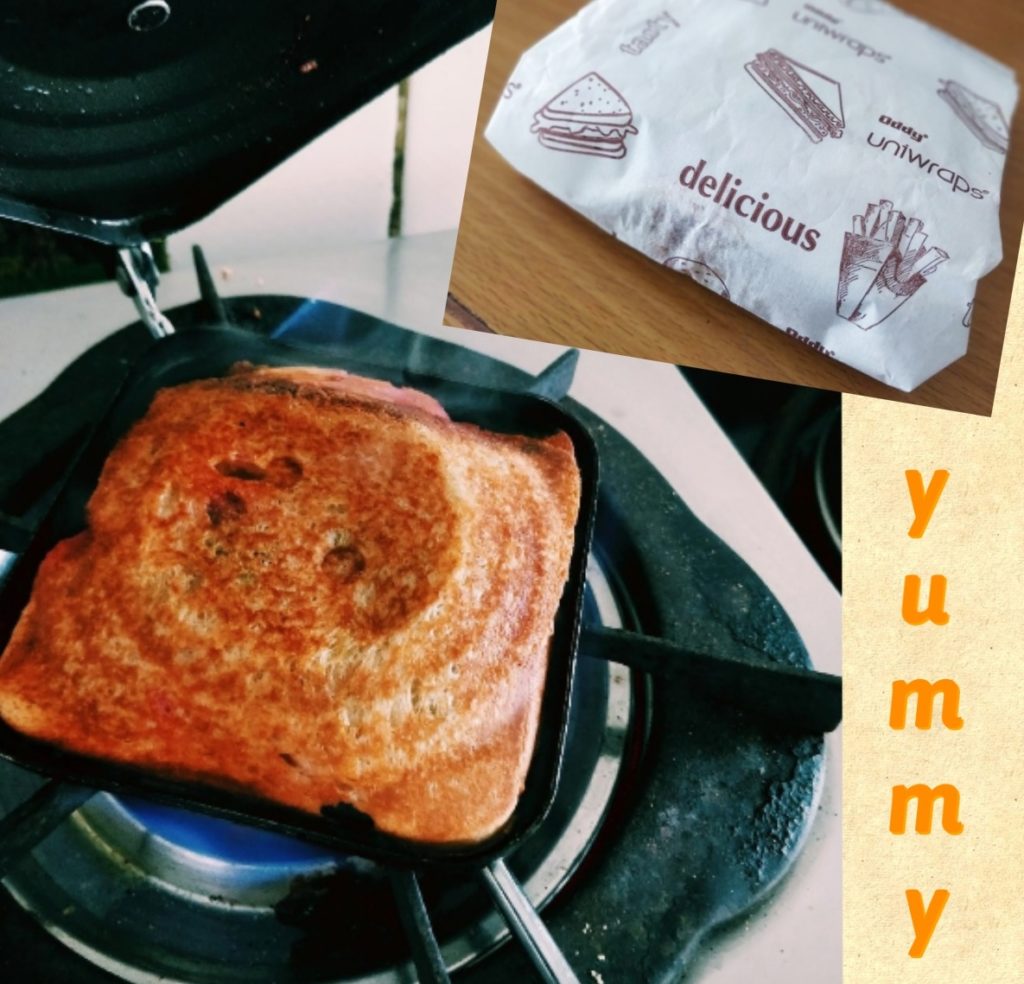
On this particular occasion, I wanted to bring the authentic ‘street food’ feel so I even packed each sandwich in food wrapping paper! But my son was not amused, rebuking me for wasting paper! 🙁
My grandma was very fond of quoting a Gujarati proverb, “Kaam kaam ne sikhve”. Loosely translated, this means that once you start working on something, new ideas will keep occurring to you and you will get better and better at your task. This turned out to be 100% accurate on this journey!
The next stop on the Great Indian Food Festival was to set up a ‘restaurant’ right in the comfort of our home. My kids love international food and they really missed eating out (funnily, they missed the ambience as much as the food – go figure!) so I decided to prepare some of their favourite dishes and present them á la carte, restaurant-style! My son even came up with a cool name for the restaurant: Viking!
Menu: hummus, tahini, pita bread, falafel, lavash, roasted beetroot dip, ginger fresco( ginger mint lime flavored drink)
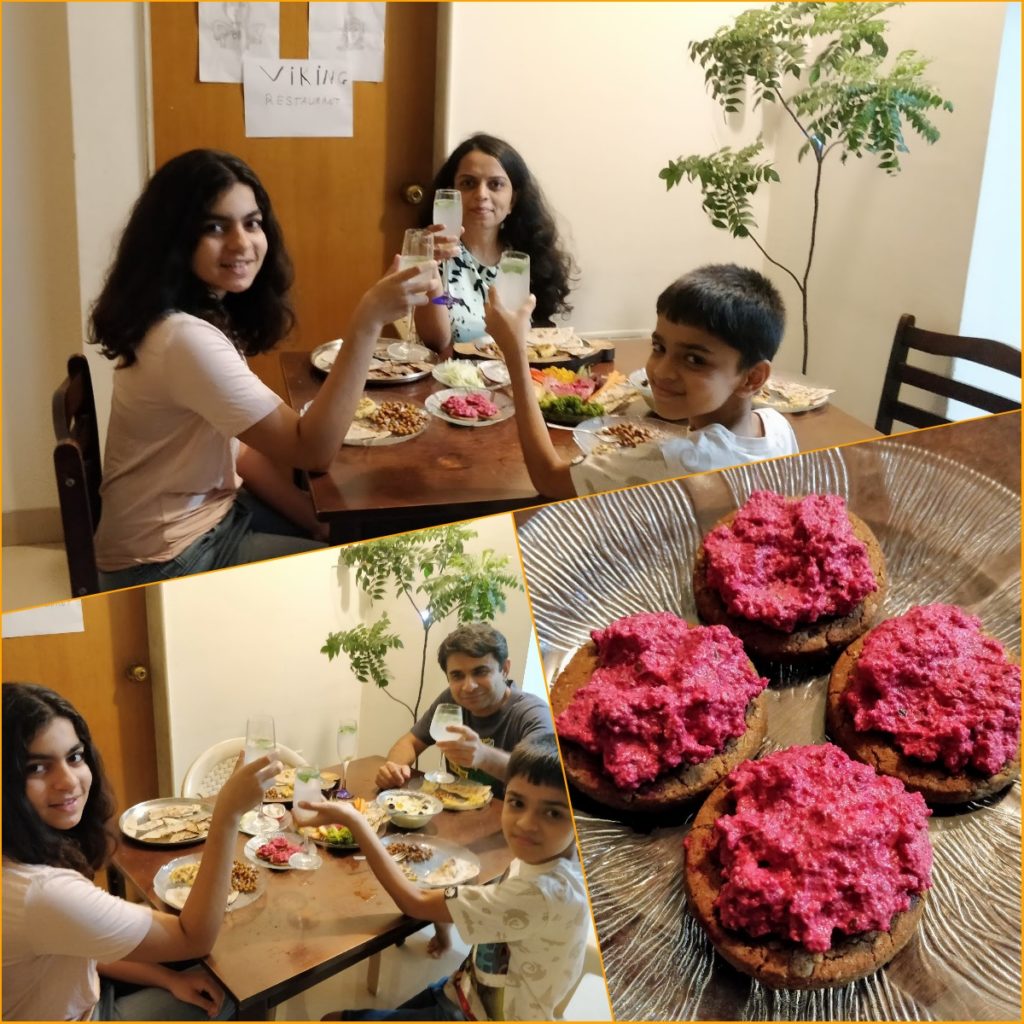
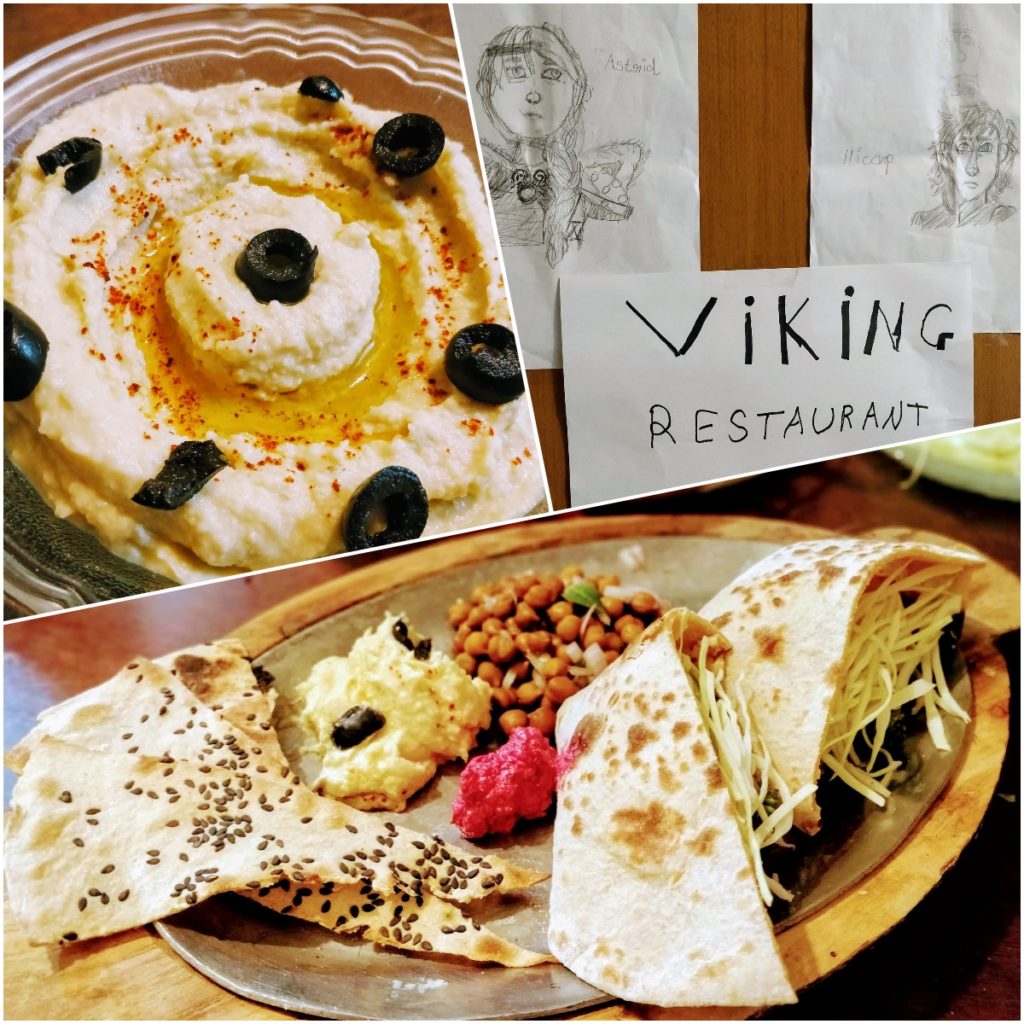
I’m grateful to YouTube (and YouTubers!) for these recipes:
https://www.vegrecipesofindia.com/hummus-recipe/
Homemade pita bread without oven
https://www.spiceupthecurry.com/falafel-recipe-fried-baked-falafel/
Recipe for Beetroot Dip:
- Roast beetroot on an open flame
- Cool and then grind to a fine paste in a blender
- Add the paste to hung curd
- Season with salt, crushed black pepper and mixed herbs to your taste (I used oregano, basil, thyme and rosemary)
For lavash sticks, I used the same dough that I had made for pita bread. I rolled out the dough into a thin round. I sprinkled some black sesame seeds and once again rolled it out into a thin roti. Then I roasted it on a flat griddle (tawa) like a khakra until it was nice and crispy. Indians are jugadoos! So here’s how it all turned out.
Next on the Great Indian Food Festival: a trip to Thailand – virtually, of course! My kids demanded Thai red curry with rice. The recipe calls for basil leaves which I didn’t have at the time. I couldn’t buy them either, thanks to the lockdown. But I didn’t want to disappoint my kids so I found a workaround – tulsi leaves! A lot of people assume that basil and tulsi are the same plant, but they are not. Anyway, my curry turned out fantastic with tulsi!
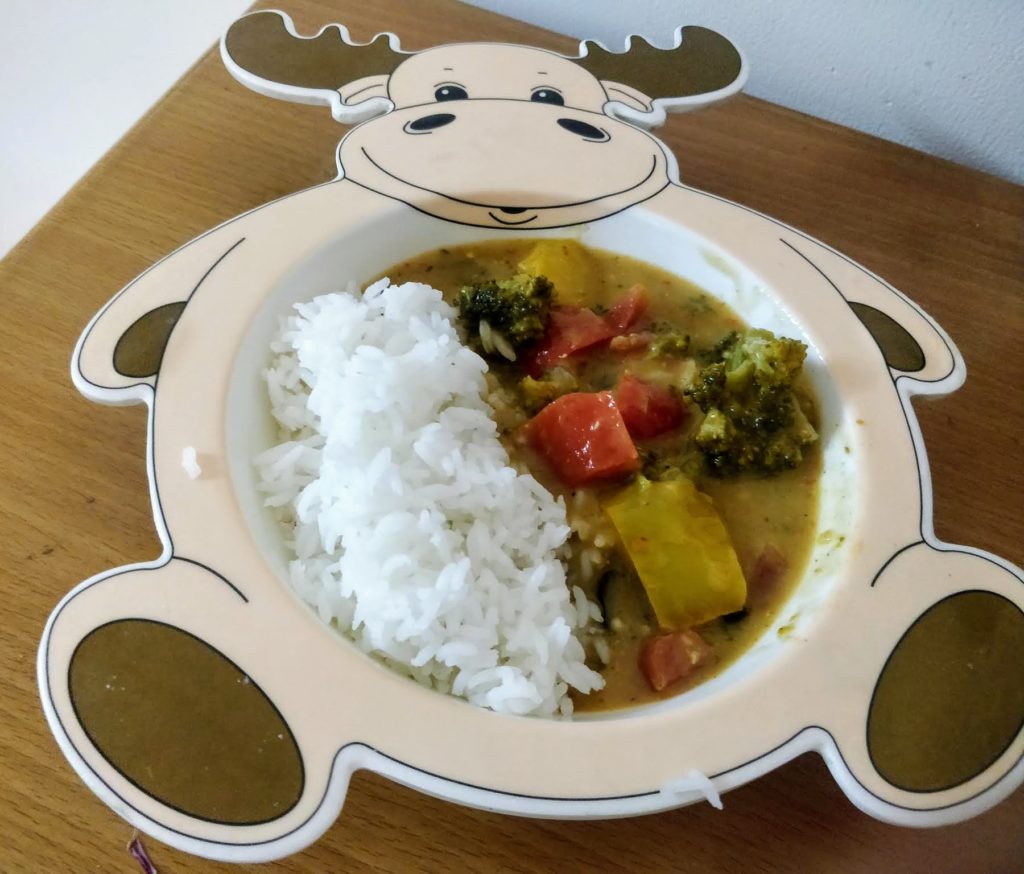
Here are the recipes I used:
https://minimalistbaker.com/easy-red-curry-paste/
https://cookieandkate.com/thai-red-curry-recipe/
Italian cuisine is also one of our favorites and pasta is a regular dish at home. However this time I tried pizza at home. Now since this is the kitchen of a chef who just made simple basic food there is obviously no oven 😉 But again thanks to the internet we found a way to make a home oven on gas – Pan with one packet of salt! Ta Da!! Wow things seem pretty simple once you start doing them. The whole house was smelling like a wood fired pizzeria.
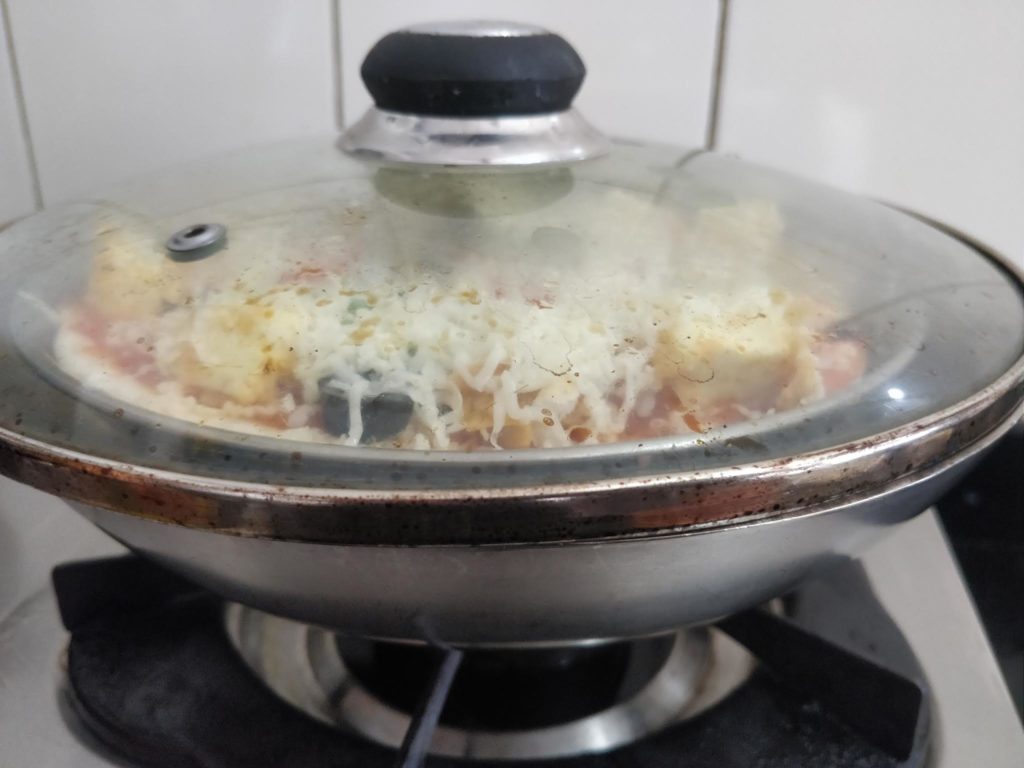
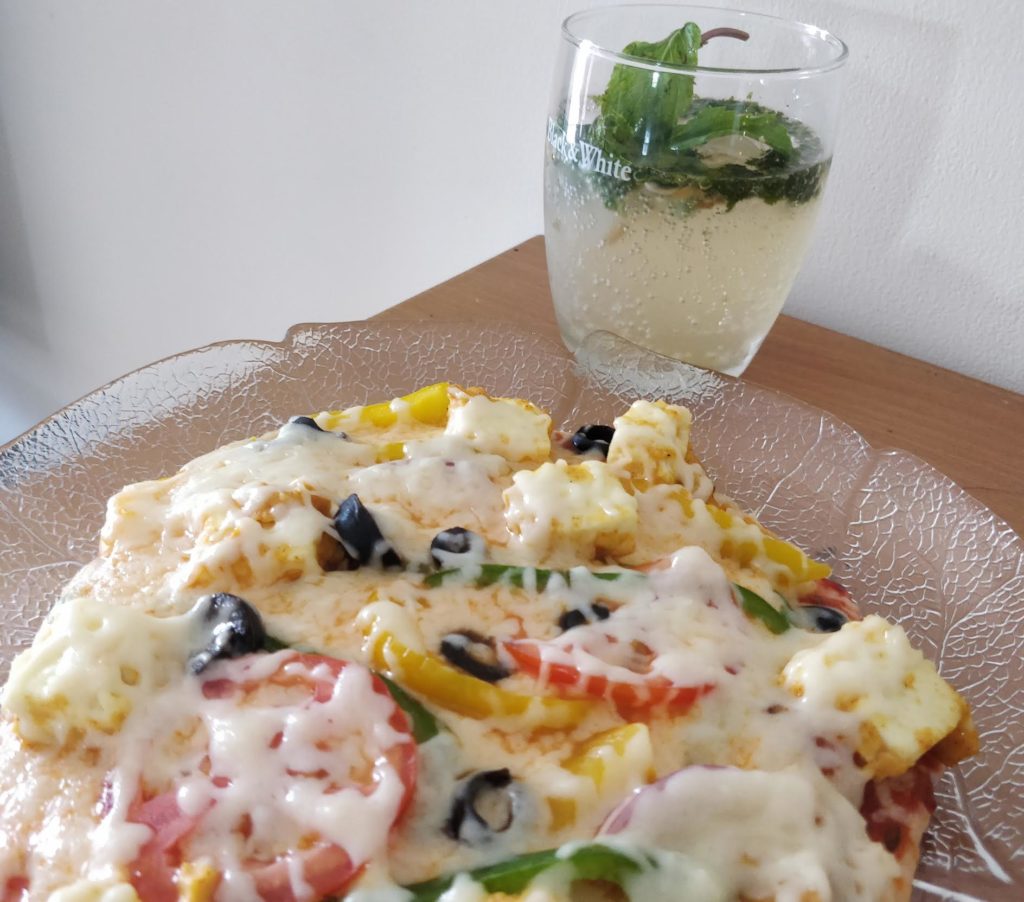
Due to the lockdown, we had not been to a restaurant for over a month. I made a deliberate decision to make my food festival an INDIAN food festival because I wanted to explore the different spectacular cuisines from various parts of my own country. I was thoroughly stoked to discover many, many new dishes. I was even more amazed when I found how the use of different spices could completely change the flavour and taste profile of familiar, mundane ingredients like vegetables and pulses. And every region in India uses spices in unique ways and combinations. I told you – amazing!
The Great Shah Food Festival ran for a full 8 days!
Day 1
The festival kicked off with my favourite South Indian cuisine. I decided to make Kanchipuram idli, medu vada, rasam and some spicy podi (dry, spicy chutney powder). I had fresh curry leaves(kadi patta) growing in a pot on my balcony so I made karuveppilai podi (dry curry leaves/peanuts chutney. Rasam is a kind of spicy broth that is usually made with yellow lentils, tomatoes and black pepper powder. However, the hero of any rasam is of course the rasam powder. I was out of this and the grocery stores were close so I made my own!
And no special meal is complete without dessert, so I made payasam (rice pudding) as well! I served the payasam at the end of our meal. But in South India, a meal always starts with payasam. It has to do with sweet foods being considered an auspicious way to start a meal – a fact that I learned from one of my South Indian friends.
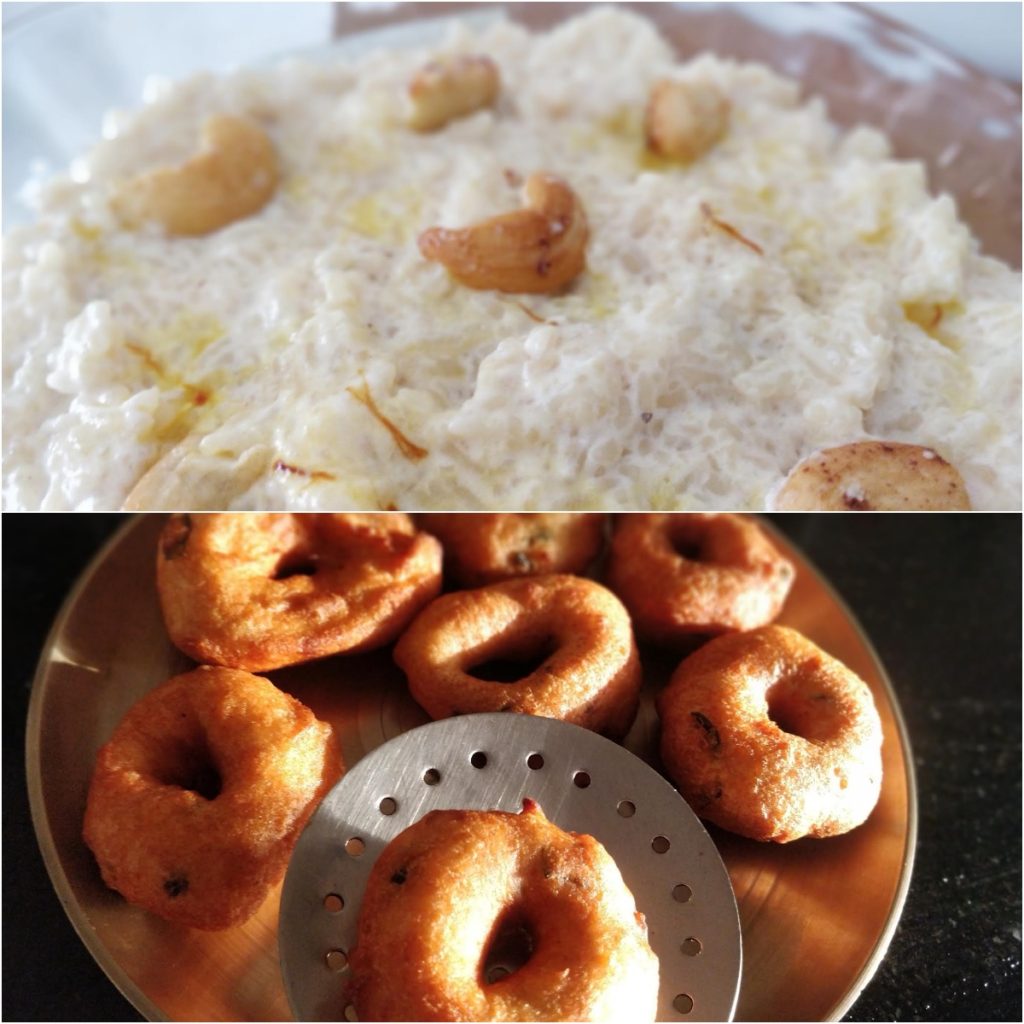
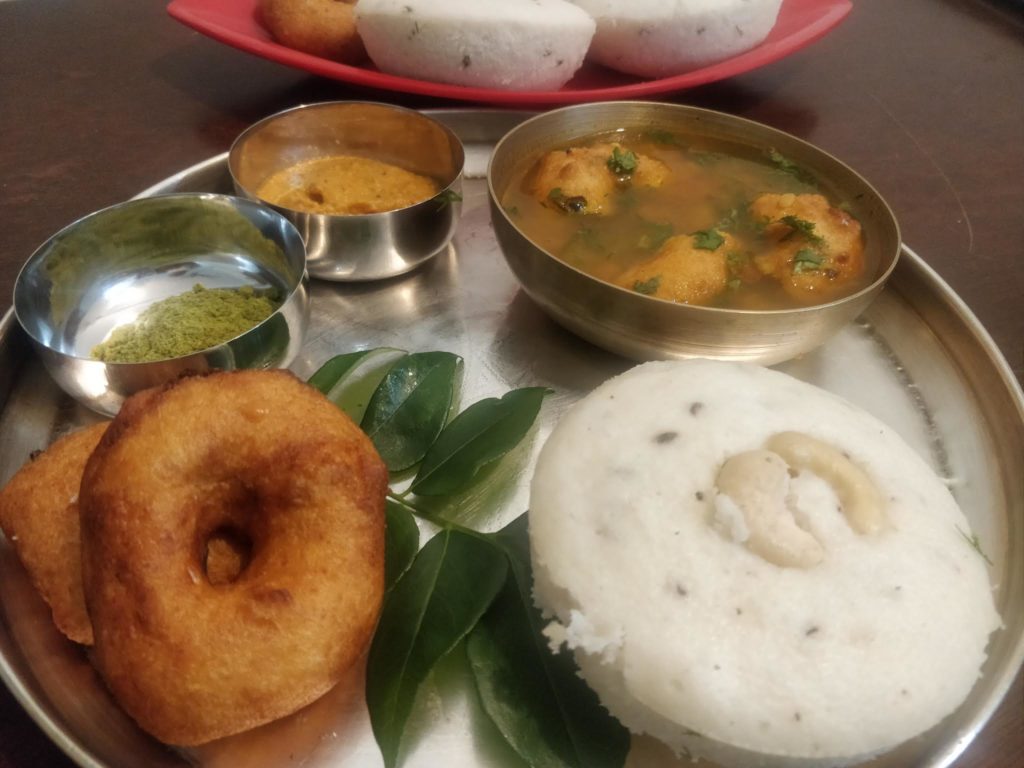
Here are the recipe links I followed:
https://www.indianhealthyrecipes.com/paramannam-recipe/
https://www.padhuskitchen.com/2009/08/karuveppilai-podi-curry-leaves-powder.html
https://www.indianhealthyrecipes.com/tomato-rasam-recipe/
https://hebbarskitchen.com/medu-vada-recipe-medhu-vadai/
Day 2
After our visit down South, it was now time to go West to Garvi Gujarat!
Even though I am a native Gujarati, I had never tried preparing Gujarati specialities on my own so the GSFF was a great time to start! Gujarati cuisine is a mix of sweet and sour.
On any given day, a typical Gujarati household will prepare a thali meal with RDBS – rotli, daal, bhaat, shaak which means roti, dal, rice, sabji. On special occasions, they prepare a special thali which contains all of these plus farsan (dried snacks) and sweets.
In honour of Garvi Gujarat, I made my husband’s favourite Gujju dishes: shrikhand (a heavenly dessert made with hung curd, sugar and flavourings like cardamom powder, saffron or even mango puree), puri (deep-fried bread), bataka nu shaak (dry potato curry), methi na gota (fried fenugreek leaves dumplings), khandvi (a popular snack made with chickpea flour and then tempered with mustard seeds and curry leaves), Gujarati meethi dal (sweet-and-sour pigeon pea or tur dal because Gujaratis love their dal sweet), bhaat (plain steamed rice) and kachumbar (tomato, onion and coriander salad).
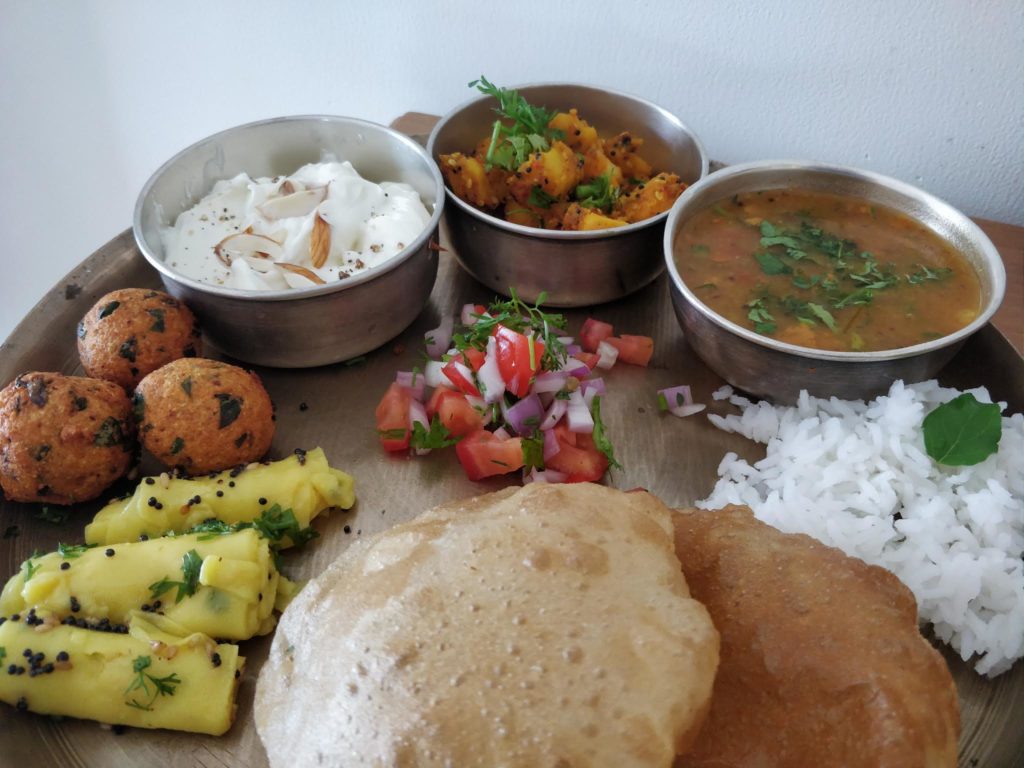
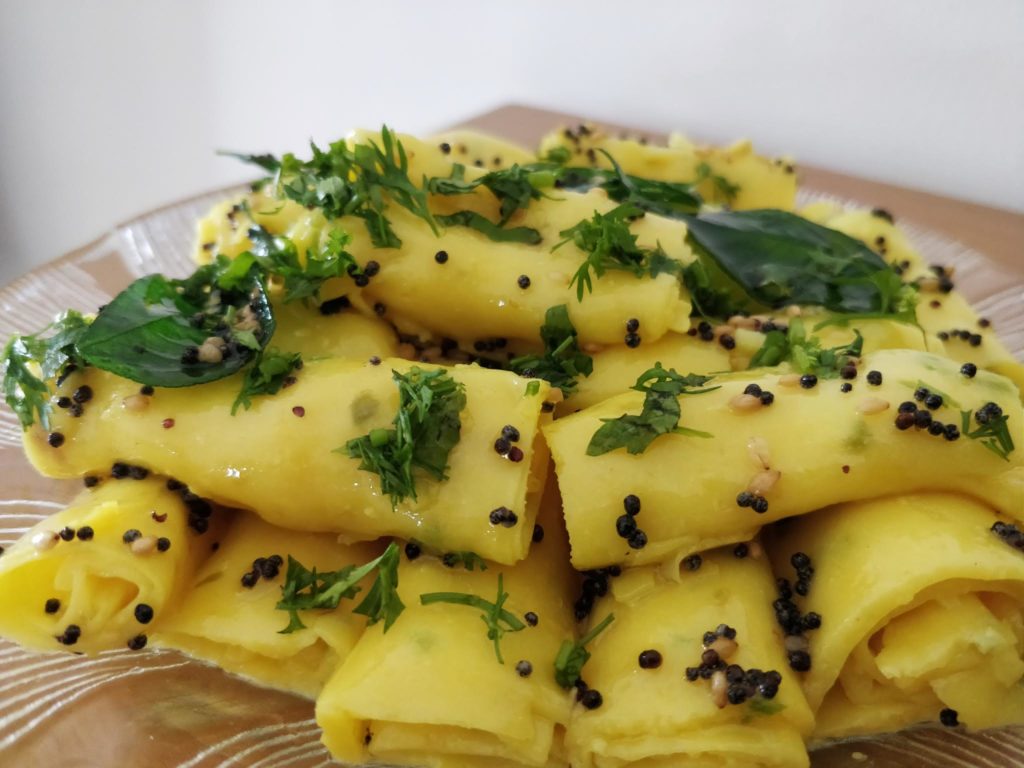
The recipes I used:
https://hebbarskitchen.com/gujarati-khandvi-recipe-pressure-cooker/
https://hebbarskitchen.com/shrikhand-recipe-shrikand-sweet/
If you want to try your hand at Gujarati cuisine, some other dishes to try are dhokla (steamed rice or chickpea flour cakes), handwo (mixed lentil cake usually made in a pressure cooker), thepla (thin shallow-fried pancakes stuffed with fresh or dried fenugreek leaves). And no, these are not names of some missiles! ☺
Day 3
After a trip to Western India, it was time to go across the country to the East to Amaar Bongal!
Personally, I was unfamiliar with Bengali food, both in terms of cooking as well as eating. This is because a majority of Bengali food is non-vegetarian (the Bengalis love their fish!) while I am a pure vegetarian. So I did a lot of research and finally found a few vegetarian dishes. I also learned that vegetarian food is often prepared during Durga Puja so I was wrong with my previous assumption that Bengali food is primarily meat- or fish-based.
Bengali cuisine has a very distinctive flavour: that of mustard seeds (rai) and poppy seeds (khus khus). A traditional spice mixture called panch phoron (literally: five spice) is liberally used, which is also unique to this cuisine.
I decided to try my hand at some traditional Bengali dishes like ucche chapor ghonto. This is one of those almost-forgotten Bengali dishes which were more popular during our grandmothers’ eras. It’s a vegetable curry by the way!). I also made luchi (the Bengali version of a puri) and begun posto (brinjal curry in a gravy made with yogurt and poppy seeds). Apparently, every posto dish helps Bengalis get in the mood for their bhaat ghoom (afternoon nap). No wonder they love it so much! ☺
And last but not least, I also made the famous Bengali dessert roshogulla – ball-shaped dumplings made from fermented milk (aka paneer) and then dunked in a sugar syrup. Yum!!! I have eaten roshogulla plenty of times but never at home. And I have always thought of it as an unhealthy, fattening sweet. But when I actually started preparing it during the GSFF, I realised that because it is made with just paneer without ghee, oil or heavy cream, the roshogolla is actually a pretty healthy dessert – as long as you squeeze out the excess sugar syrup (chashni). No guilt dessert – enjoy!
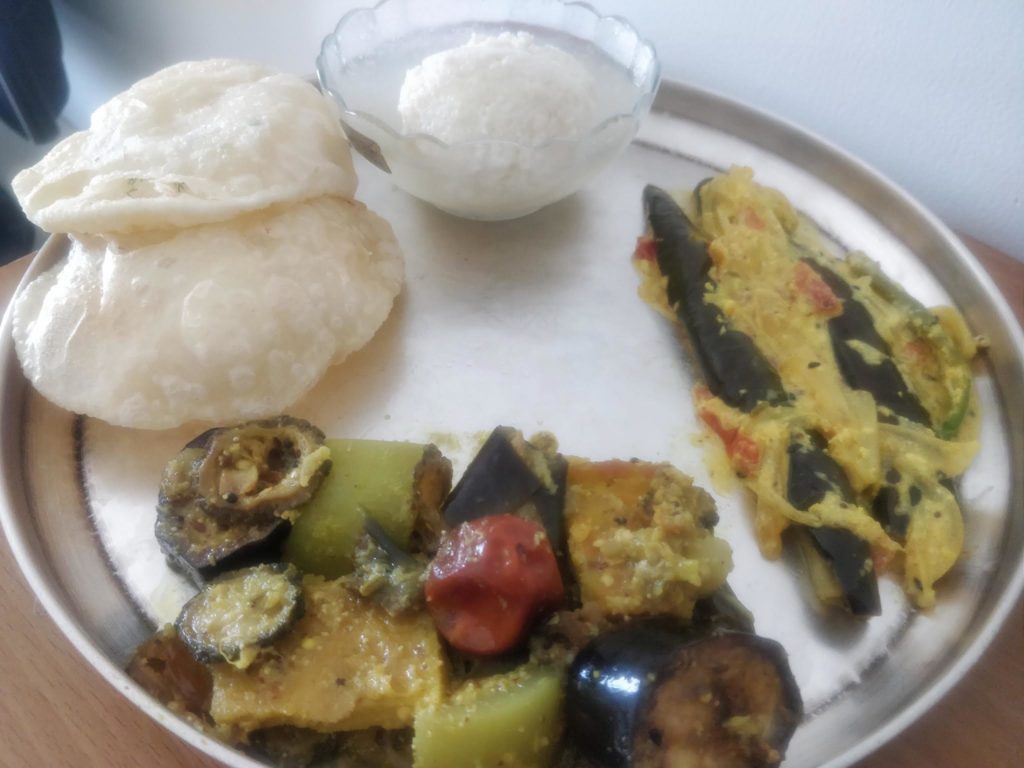
Here are the recipe links I followed:
For making Chapor ghonto curry
Roshogulla recipe (Apparently, the chef failed 30 times before he got this one right ! But I did quite well on my very first try) 😉
Day 4
Time for a trip to the land of the brave Rajputs: Padharo Mhare Des Rajasthan!
Rajasthan is one of my favourite Indian states to travel to because it offers grandeur, culture, pomp and food like no other!
As part of the Great Shah Food Festival, I decided to make all of my personal favourite dishes. One of these is mirchi bada, a Jodhpur speciality. This is basically long, fat (and non-pungent) green chillies stuffed with a potato mixture and then deep fried. I also made pyaaz ki kachori (a deep-fried pastry with spicy onion stuffing), gatte ki sabzi (a yogurt-based gravy with chickpea dumplings) and satpadi roti (a 7-layered unleavened bread). To round off the meal, I also made ghevar which is a special dessert of all-purpose flour dumplings soaked in a sugar syrup.
With the other dishes, I was a little anxious – the videos made them all look so complex! But slow and steady wins the race…and I won! All the dishes turned out perfectly well and they were super delicious!
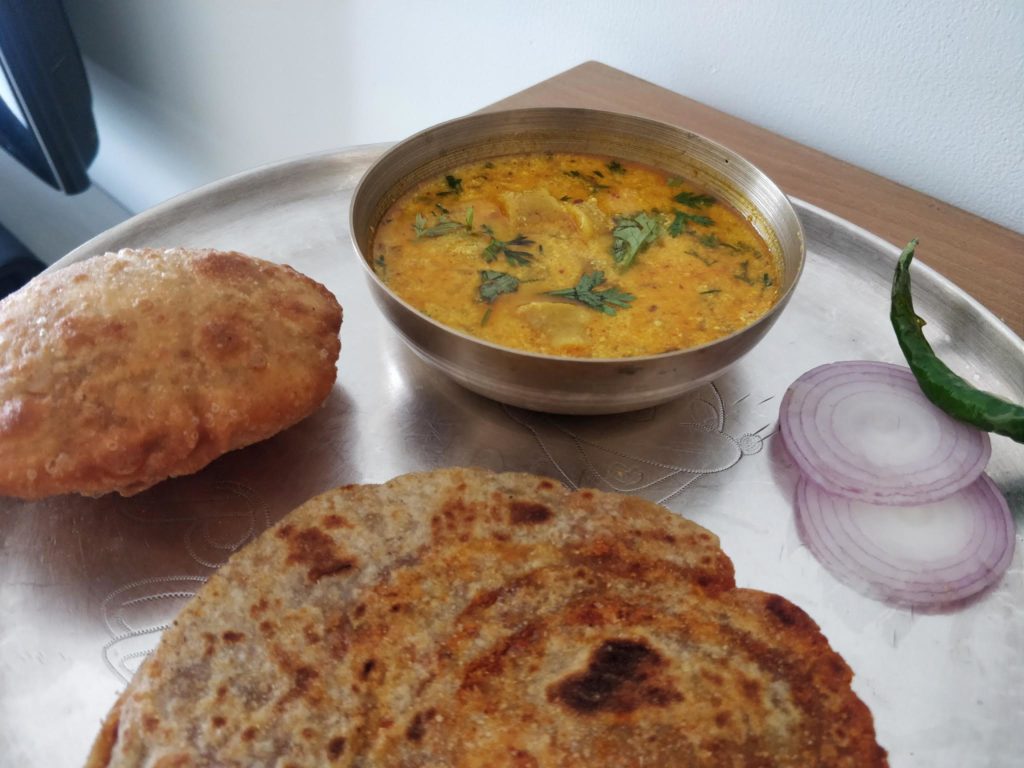
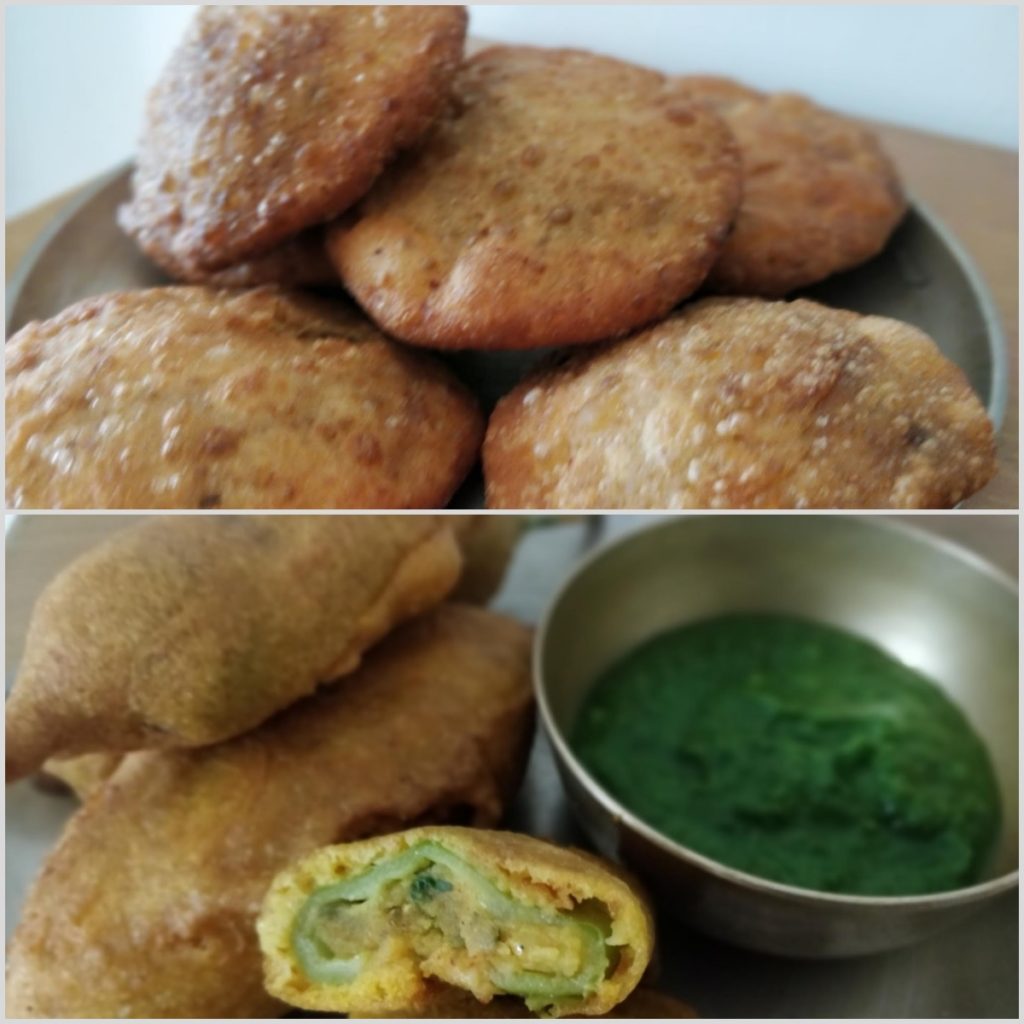
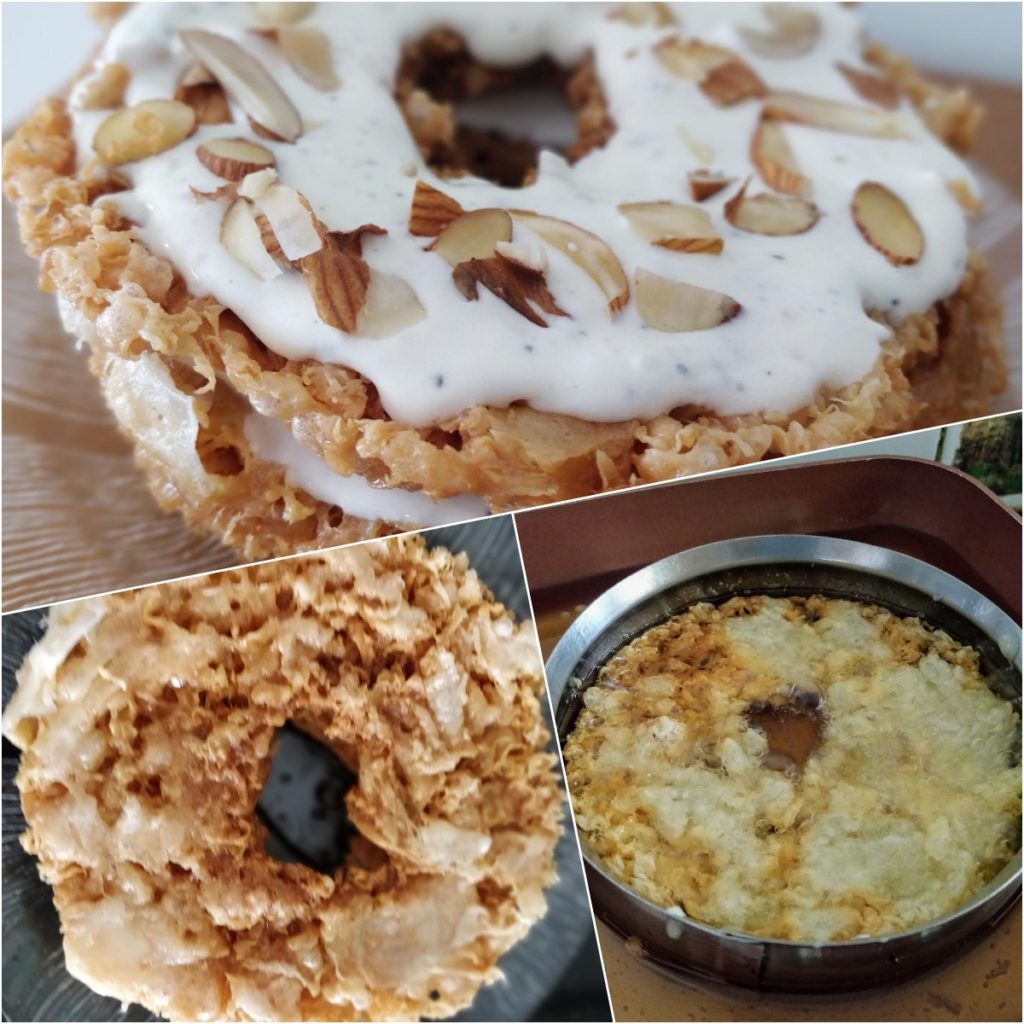
Here are the recipe links:
https://hebbarskitchen.com/gatte-ki-sabji-recipe-gatte-ki-sabzi/
https://hebbarskitchen.com/mirchi-bada-recipe-mirchi-vada/
https://hebbarskitchen.com/ghevar-recipe-crispy-porous-ghewar-home/
Day 5
A trip to the land of Shivaji Maharaj: Jai Maharashtra!
I have lived in Mumbai (capital of Maharashtra) all my life but I had never tried my hand at traditional Maharashtrian cooking. In fact, the first thing that always came to my mind when I thought about Maharashtrian cuisine was vada pav . Maharastrian cuisine is nutritious, super tasty and most dishes are easy to make. No complicated techniques or exotic ingredients required!
This time, I decided to explore dishes like sabudana vada (deep-fried dumplings made with a spicy sago mixture), kothimbir vadi (a delicious savoury snack made from a mixture of boiled potatoes, chickpea flour and coriander aka kothimbir leaves), matkichi usal (sprouts curry), jowarichi bhakri (thick rotis or unleavened bread made from jowar aka sorghum flour), sheng sola (a vegetable stew ) and hirva thecha (a spicy semi-dry chutney made with green chillies, garlic and peanuts). And of course how could I leave out Maharashtra’s famous dessert, modak. This sweet is usually made from paneer or rice flour and often served as prasad during Maharashtra’s famous Ganesh festival. Peanuts are an important ingredient in Maharashtrian cuisine.
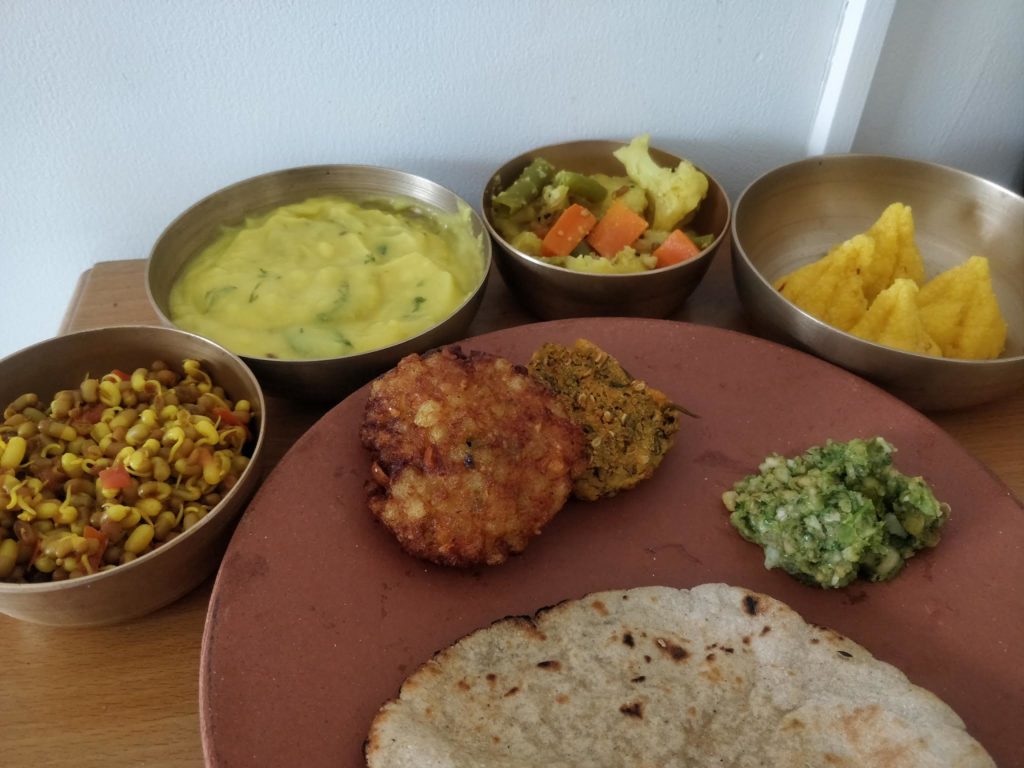
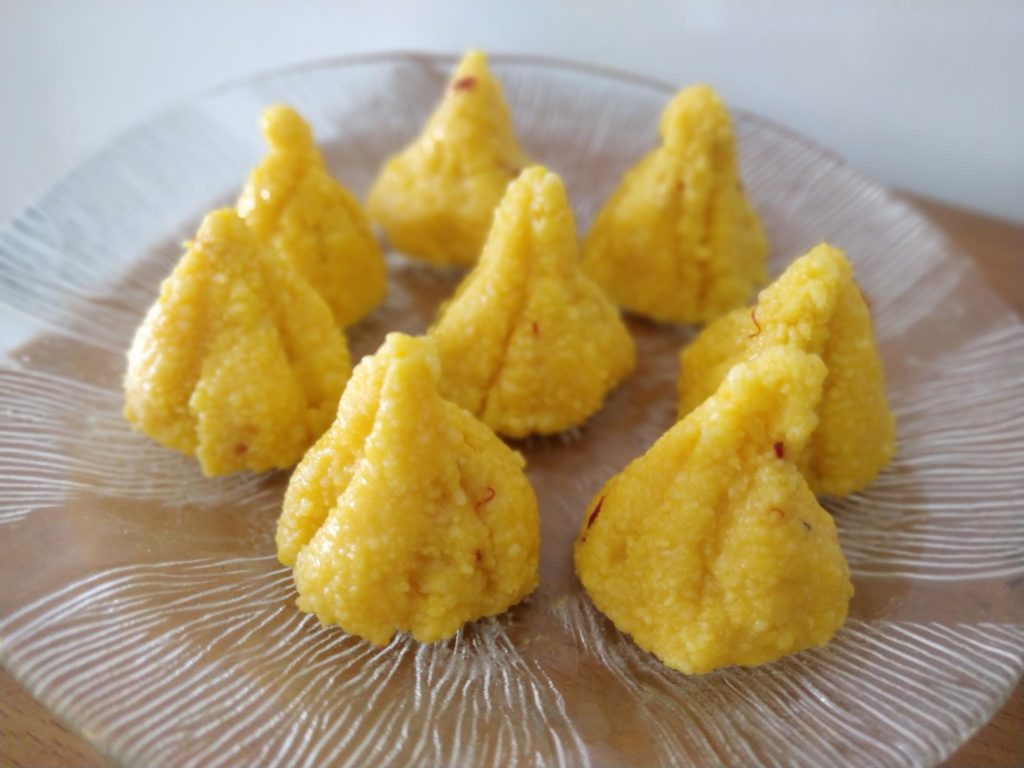
Here are the recipes I followed:
https://www.indianhealthyrecipes.com/sabudana-vada-recipe/
https://www.tarladalal.com/Maharashtrian-Pitla-Pitla-Recipe-Besan-Pitla-Recipe-40781r
https://www.spiceupthecurry.com/malai-modak-recipe-paneer-modak/
https://www.archanaskitchen.com/maharashtrian-style-sheng-sola-recipe-vegetable-stew
https://www.tarladalal.com/Green-Chilli-Thecha-Hirvi-Mirchi-Cha-Thecha-40157r
Day 6
Time to go up North and visit Punjab da dhaba!
Punjabi cuisine is probably the most popular cuisine in India. Most restaurants in India and even abroad serve Punjabi food. In fact, it has been my experience that outside India, ‘Indian food’ is synonymous with ‘Punjabi food’. So if you will find indian restaurants in Paris, Alesund, Rotorua serving chhole bhature, garlic naan, butter chicken or paneer makhanwala.
I decided to make paneer masala( panner curry), dal makhani( whole black lentil dal with lots of makhan->makhani) and tandoori roti. The tandoor (brick-lined clay oven) has been an inseparable part of Punjabi cuisine for centuries. It was brought to India by Punjabis before partition. Apparently, it was introduced to India and Indians – Punjabis in particular – by the Mughals. Today, the tandoor is used to make tandoori rotis, paneer tikka and a plethora of other dishes. Believe me, food cooked in a tandoor has an amazing smoky flavour that is out of this world!
I don’t have a tandoor at home but I decided to try my hand at making tandoori rotis. How, you ask? Well, you can replicate the flavour of a tandoor to a large extent even with a regular gas stove! See the link I have provided below to know more!
Dal makhani is a gorgeous and super-tasty Punjabi dish that was invented by Kundan Lal Gujral, a Punjabi migrant who was born in what is now Pakistan. He came to India after the Partition in 1947 and eventually set up the popular Moti Mahal restaurant in Delhi, where dal makhani still features prominently on the menu.This is Punjabi food so don’t even think of skimping on the fat. Bye-bye diet! ☺
Ramadan was going on and due to lockdown I missed my phirni ( a rice pudding with amazing flavours of cardamom, saffron and rose water) so I decided to make it for dessert. I love the gooey texture of this dessert.
No Punjabi meal is complete without the famous lassi! This is Punjab’s unique take on sweetened yoghurt that is both a dessert and an after-meal digestive. Go figure!
By the way, plenty of Bollywood films feature fathers saying something like “Lassi pee le puttar” (enjoy some lassi, son)! ☺ ☺
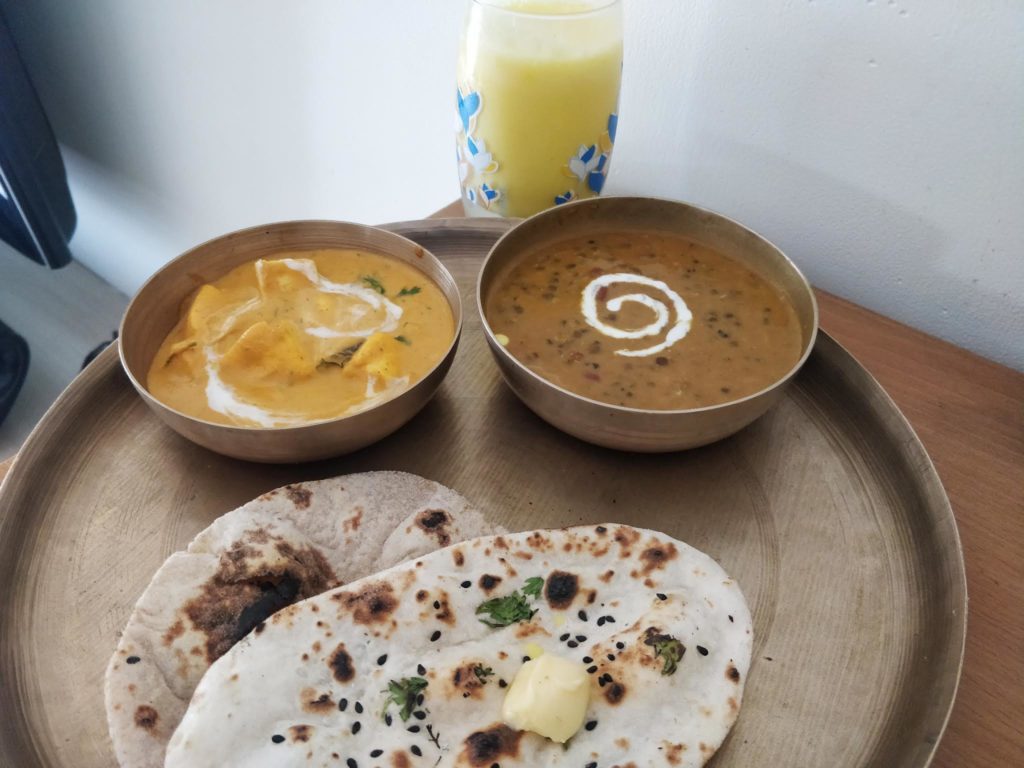
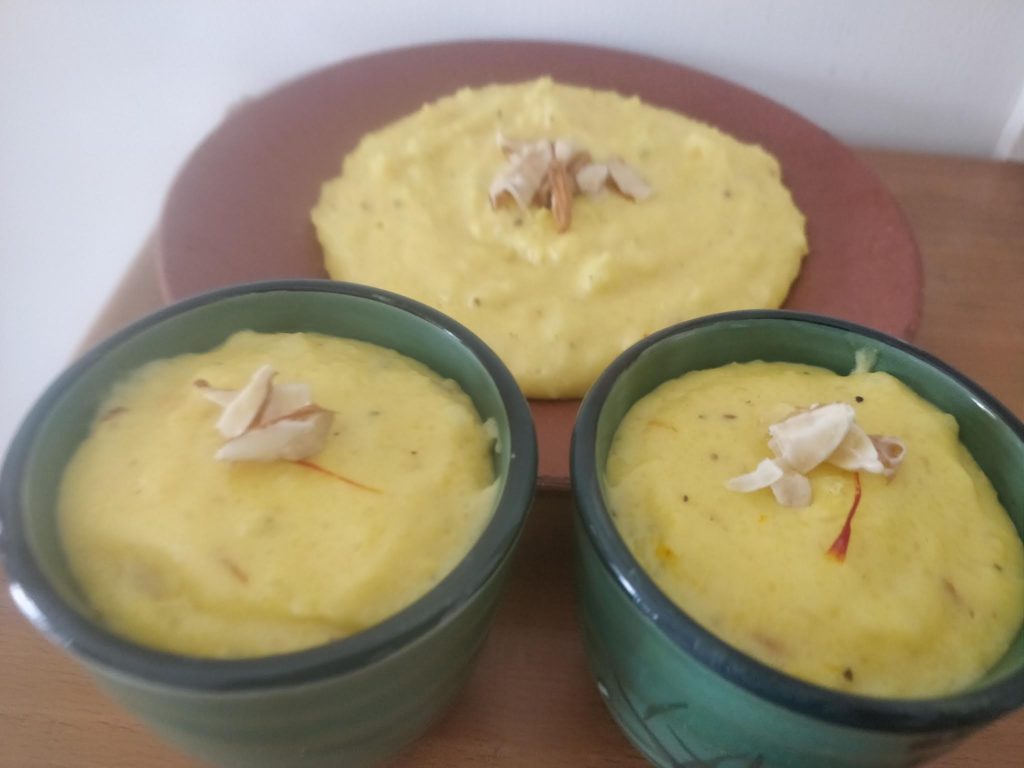
Here are the recipes:
Phirni recipe – I added rose water as my variation to the recipe here : https://hebbarskitchen.com/phirni-recipe-firni-recipe-rice-phirni
https://hebbarskitchen.com/tandoori-roti-recipe-roti-tawa-stove-top/
Day 7
Ni chi bao le ma? Today was dedicated to Indian Chinese!
Most non-Indians don’t understand what Indian Chinese is all about. Is it Indian? Is it Chinese?
Well, it’s both!
Indian Chinese cuisine is basically Chinese food adapted to suit Indian tastes. It is extremely popular in India, but believe me, the Chinese don’t eat this kind of food – at all! In fact, Indian Chinese is more Indian than Chinese! However, the ingredients like soya sauce that are commonly used in this cuisine originated in China – they are definitely not used in Indian food – so the name has stuck.
Personally, I’m not too fond of this particular cuisine and almost never eat it outside of home because restaurants use unhealthy flavouring ingredients like ajinomoto. I never have it in restaurants too. However, I made an exception for the Great Shah Food Festival.
I made vegetable fried rice, manchurian (deep-fried vegetable balls served with a spicy gravy) and chilli paneer (spiced paneer cubes cooked in a spicy flavoured sauce) and Schezwan noodles( spicy noodles) and dark chocolate brownie with mango coconut filling stuffed in between.
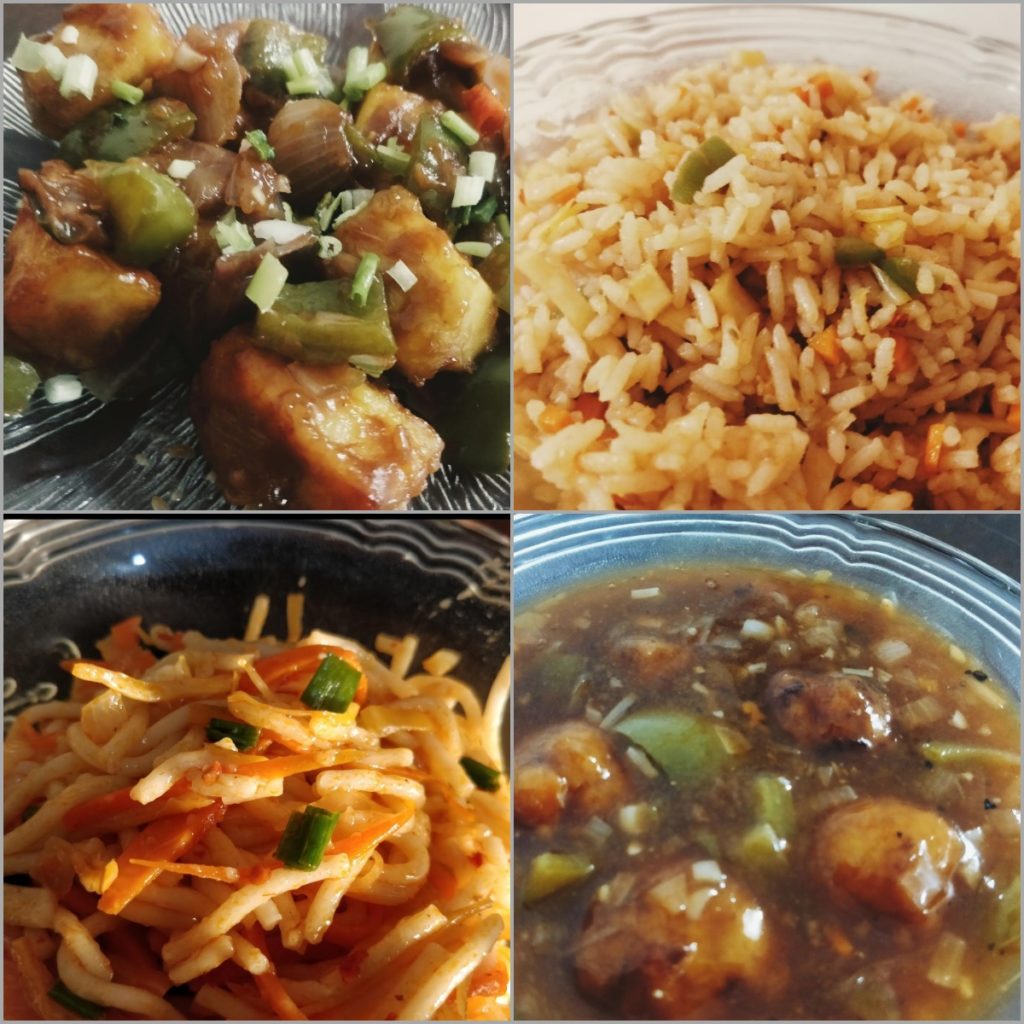
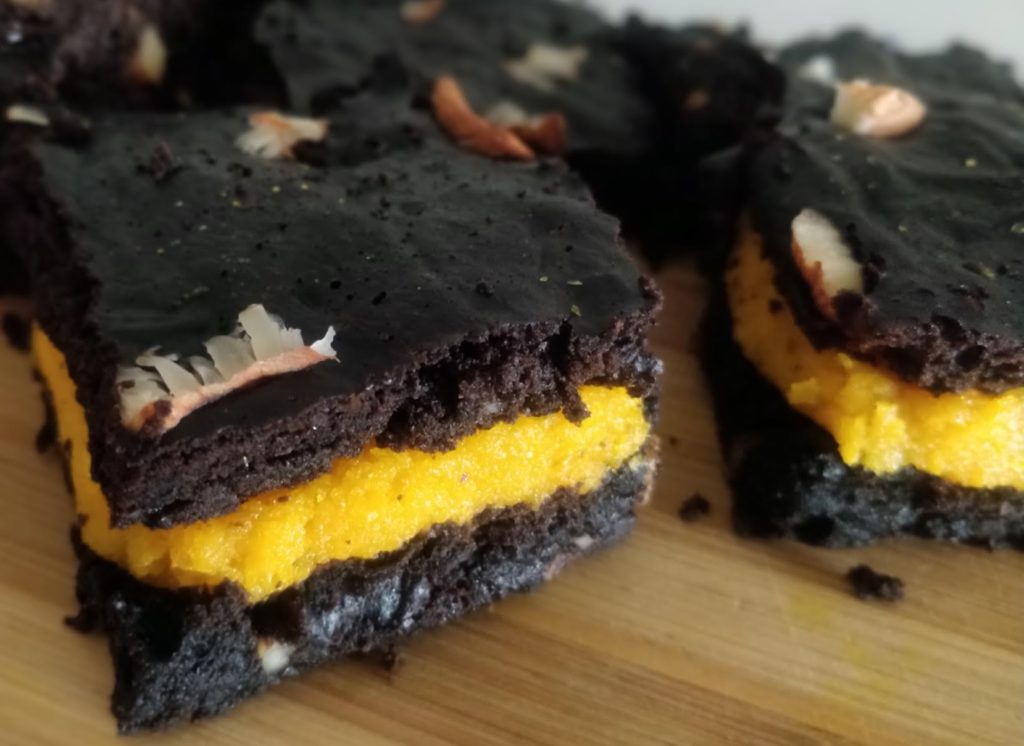
Here are the best recipes I found:
Day 8
The grand finale: my favourite state Sikkim!
I have always loved to travel to Sikkim, a small state in India’s North East. A rugged, mountainous terrain, stunning natural beauty, friendly locals and amazing food – Sikkim has it all!
The first time I visited Sikkim, I happened to try the thukpa and fell in love! Thukpa is a spicy noodle soup that often contains chicken or beef. However, vegetarian versions are available as well and it is absolutely am-ah-zing! Momos is another dish that is synonymous with Sikkimise cuisine. These dumplings are made with all- purpose flour (maida) and then stuffed with either a meat or vegetable filling.
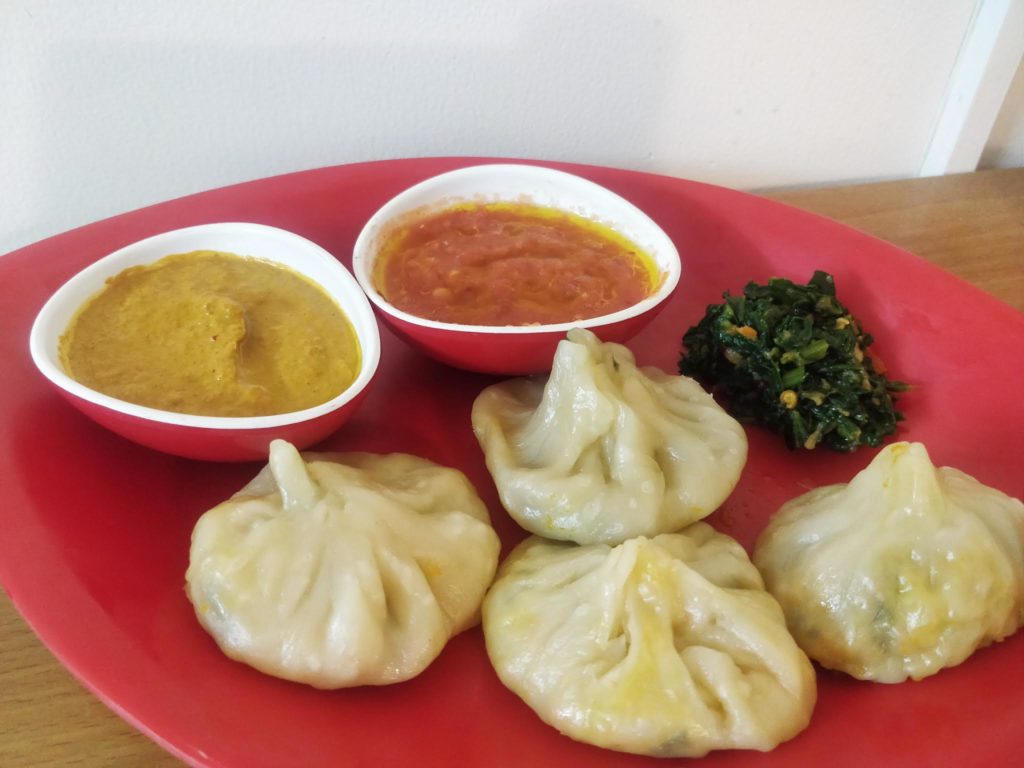
When I decided to try my hand at Sikkimese food, I looked at dozens of videos. However I found no thukpa recipe that really appealed to me. Finally, I decided to make my own version based on a couple of videos to which I added my own flair. And authentic thukpa has freshly-made noodles so I made my own!
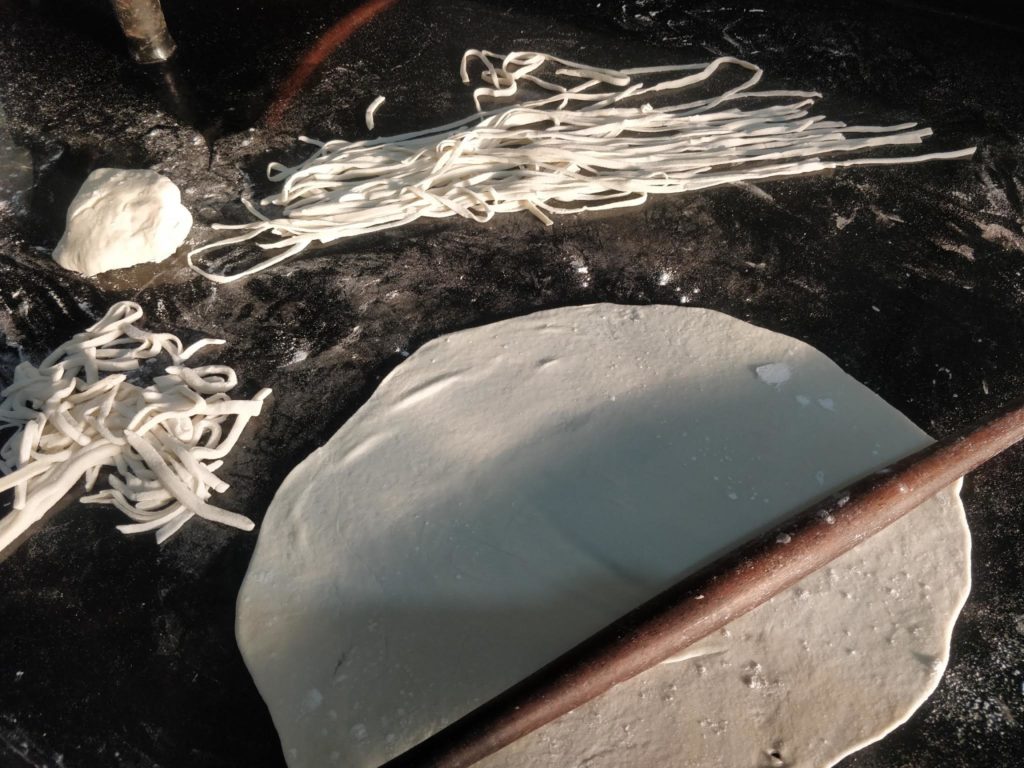
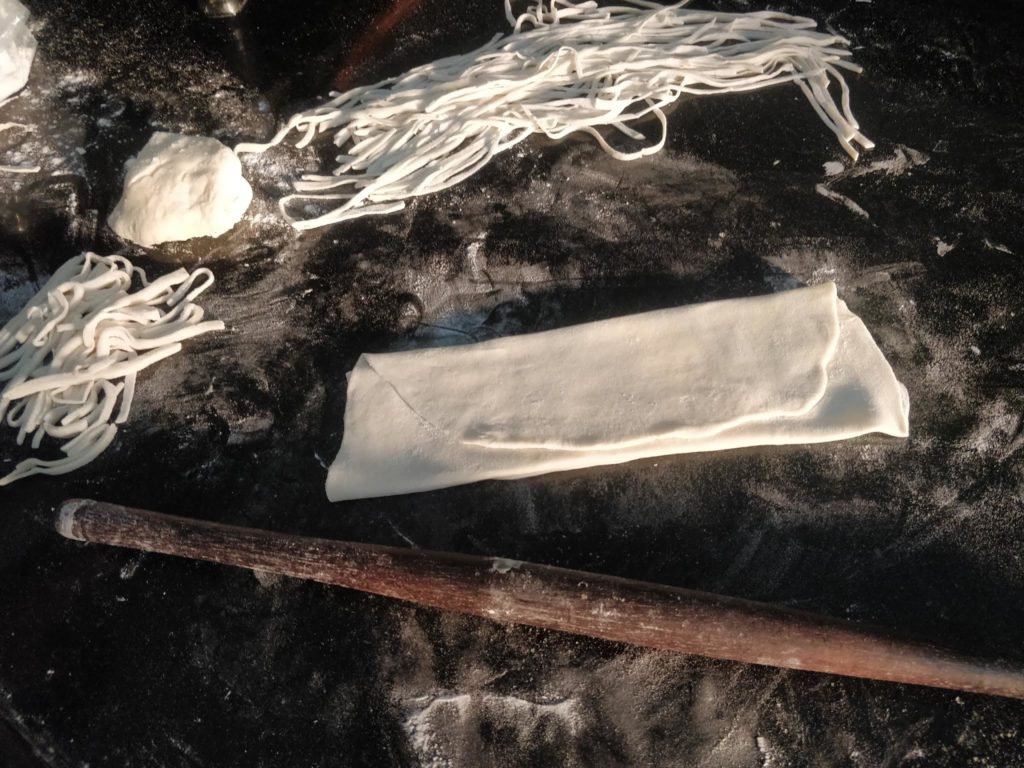
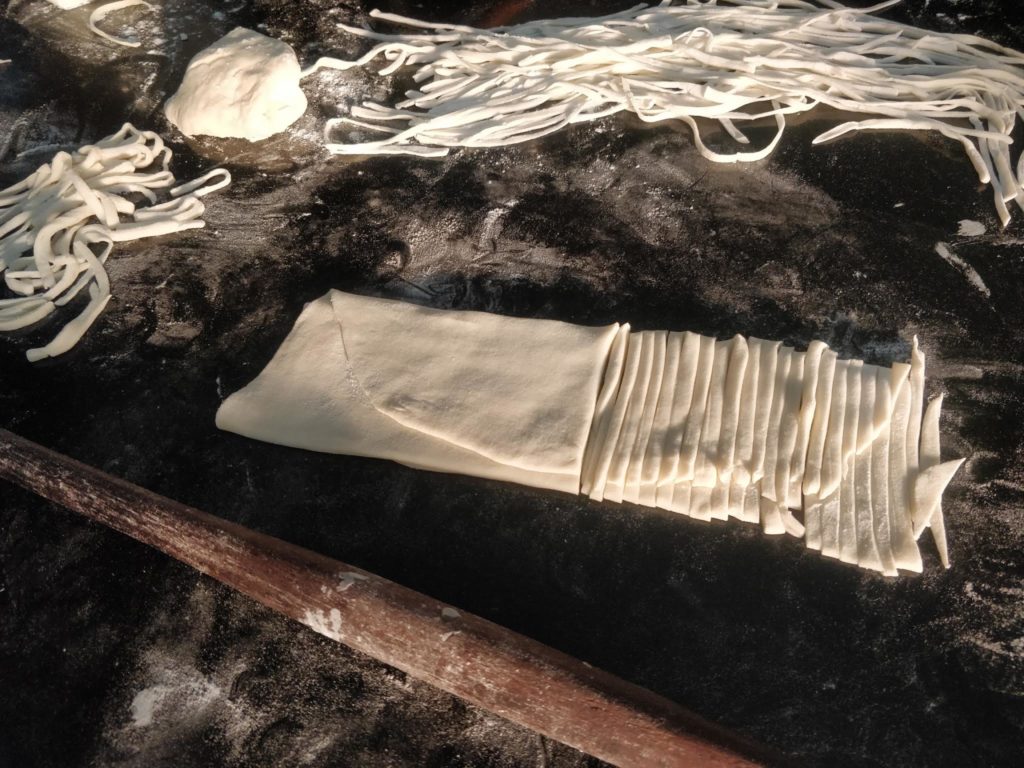
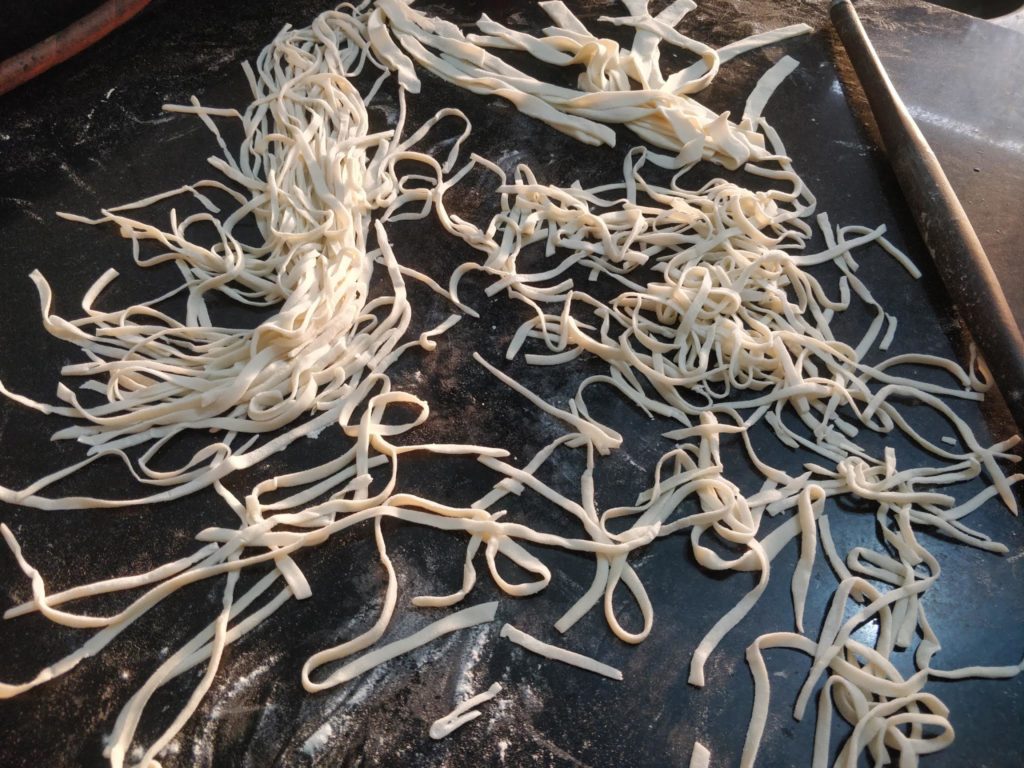
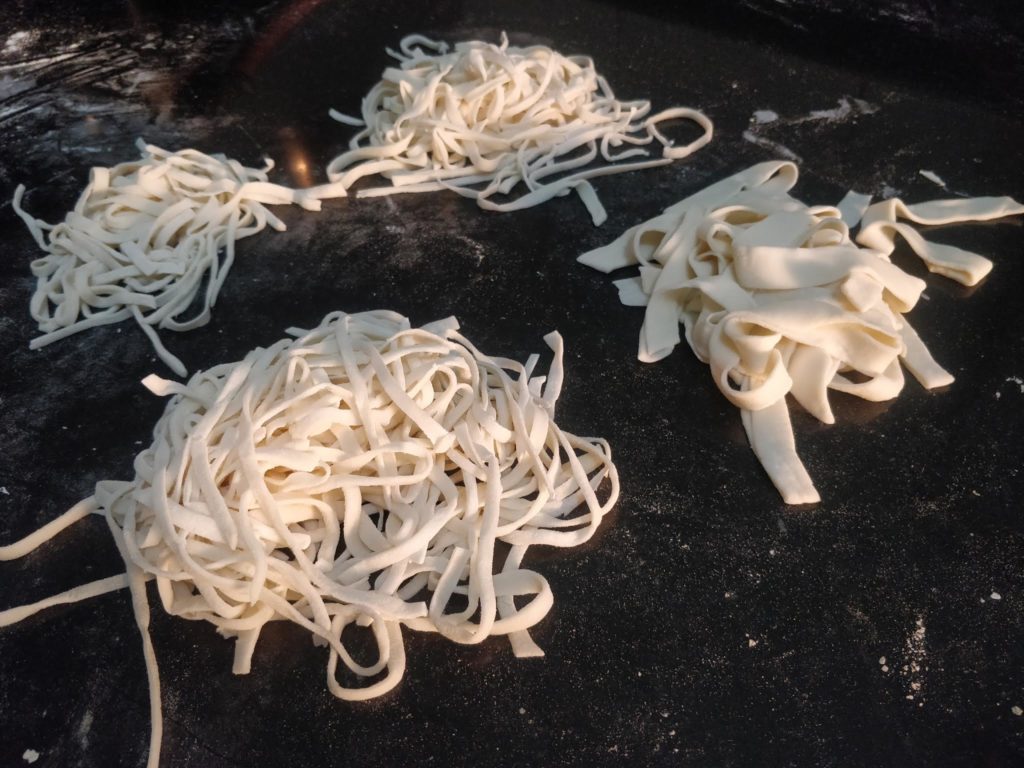
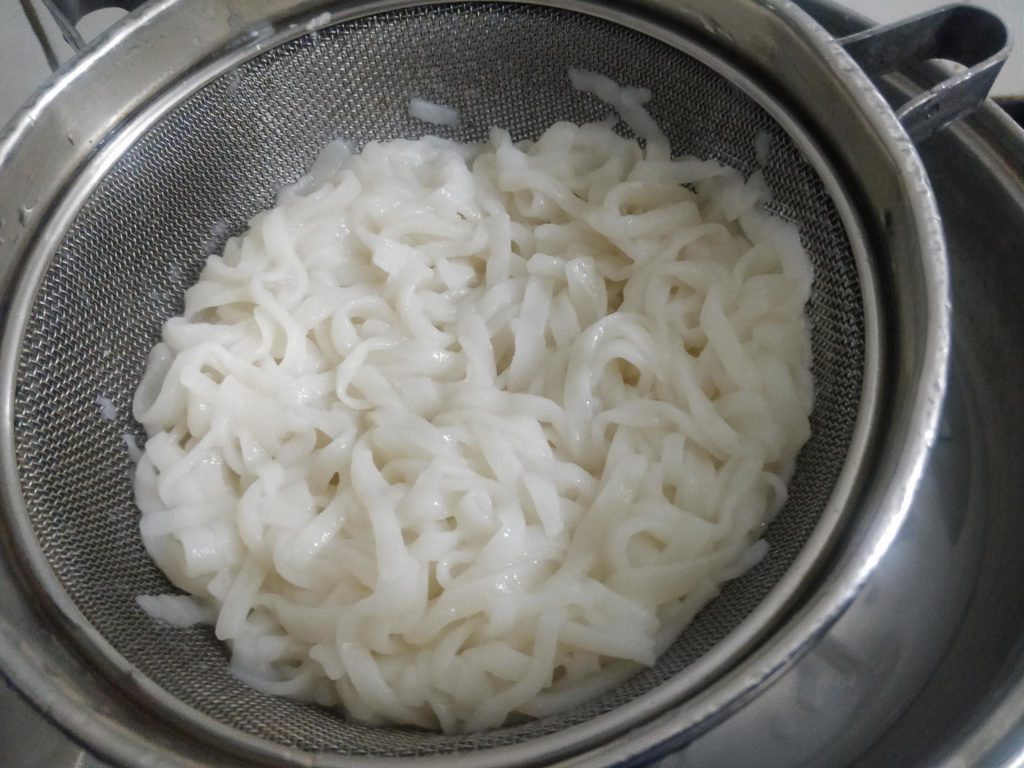
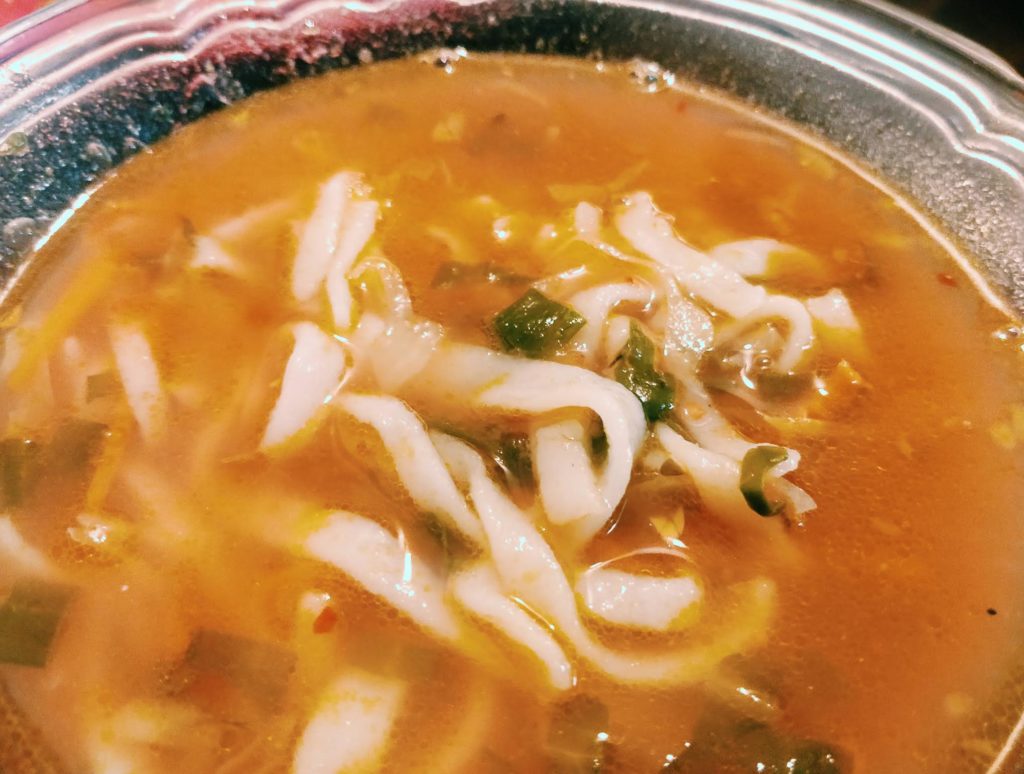
Here are the recipes I followed:
How to make noodles at home (honestly, this was very therapeutic for me!) ☺
And with that, the Great Shah Food Festival came to a glorious end! We went back to our simple home-cooked meals with some beautiful memories of the food we cooked and enjoyed. These 8 days reminded us all to be grateful for the food we eat and to be more mindful in our food choices and eating habits. I also learned a lot about food preparation techniques, spices and previously unfamiliar ingredients. Thanks to the Great Shah Food Festival, my kitchen and home have now become spaces for free experimentation and untold creativity.
Why not launch your own home Food Festival? I promise you will love it! Do remember to share your experiences below!

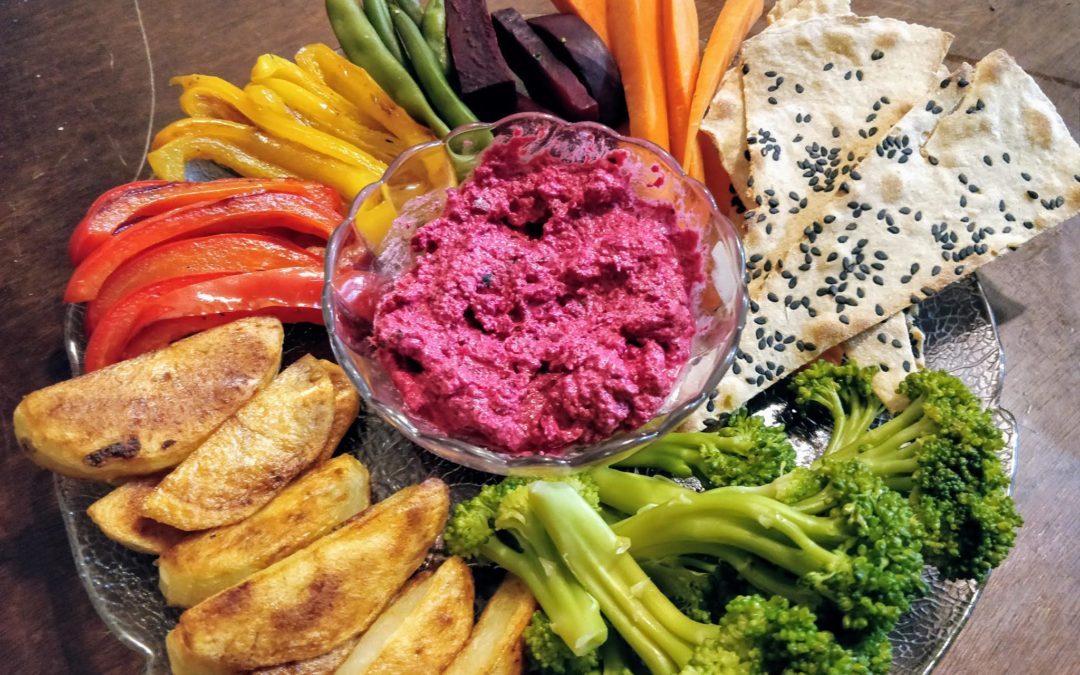
All the above looks like some serious hard work from the outside, but SOUNDS FUN the way you have penned it.. Great write up..
Leaves me astounded with all the hard work and sweat you put in to create that joy of the palate into the household plate …true to the family, true to the gratification , through to food nirvana ….!
I might just fall short of words after reading so many words with so many emotions. From getting the a bingo with cooking part, presenting, then taking pictures, sharing with your friends you did come a long way!!! Agreed .
What surprised me the most was when you put all of it in words!!
That just shows the hard work put in.
Loved the read!!
Hello, Awesome Article, and Your information is very amazing and so much useful for me. Keep it up and thank you very much.:)